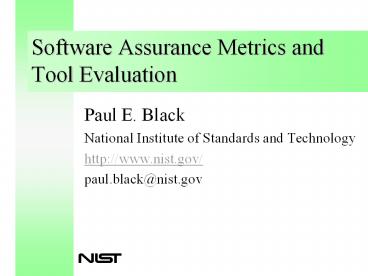Software Assurance Metrics and Tool Evaluation PowerPoint PPT Presentation
Title: Software Assurance Metrics and Tool Evaluation
1
Software Assurance Metrics and Tool Evaluation
- Paul E. Black
- National Institute of Standards and Technology
- http//www.nist.gov/
- paul.black_at_nist.gov
2
Outline
- Introduction
- SRD project
- SAMATE project structure
- Future where do we go now?
3
What is Software Assurance?
- Activities that ensures that software processes
and products conform to requirements. - after NASA Software Assurance Guidebook
- Two legs of good software
- Good Development
- Good Checking
- Testing (dynamic)
- Analysis (static)
4
NISTs role
- What is NIST?
- A non-regulatory agency in Dept. of Commerce
- 3,000 employees in Maryland and Colorado
- Primarily research, not funding
- Why NIST?
- Over a century of experience in standards and
measurement - Involved in security DES, AES, NVLAP, etc.
- Trusted, neutral 3rd party
5
The Two Projects
SAMATE Software Assurance Metrics And Tool
Evaluation
SRD Standard Reference Dataset
6
Outline
- Introduction
- SRD project
- SAMATE project structure
- Future where do we go now?
7
SRD Project Goals
- Identify classes of security flaws and
vulnerabilities - Identify classes of software security assessment
techniques - Document state of the art
- Develop a Standard Reference Dataset (SRD) of
clean programs and programs with security flaws
8
SRD Characteristics
- Small test cases for each flaw
- Separate can detect from speed issues
- Flawed programs and their clean counterparts
- Very large test cases
- Confirm speed and maximum size
- Test cases taken from actual code
- Nobody can say it would never happen
- Many different subsets
- Java, C, web app, OS, Windows, Unix, etc.
- Ongoing development and additions
- Submissions from NIST, researchers, vendors
- Readily usable
9
SRD Project Plans
- Small workshop
- http//samate.nist.gov/softSecToolsSOA
- 10 11 August at NIST
- Publish proceedings as NIST Special Publication
put in ACM Digital Library - Write journal article on
- classes of known software security
vulnerabilities and - the state of the art of security SA tools
10
Outline
- Introduction
- SRD project
- SAMATE project structure
- Future where do we go now?
11
DHS Software Assurance Plan
- 1. PEOPLE (Education/Training)
- Software Developer focused training and education
- 2. PROCESS (Lifecycle, Best Practices,
Standards) - Security throughout the Software Development Life
Cycle - 3. TECHNOLOGY (Tools and RD)
- SA tools identification, enhancement, and
development - 4. ACQUISITION (SOW / Procurement language)
- Embed security requirements in procurement stage
12
The SAMATE Project
- http//samate.nist.gov/
- Compendiums (ongoing)
- Tools
- Researchers and companies
- Workshops
- Aids for tool evaluation
- Software metrics
13
Workshops
- Taxonomy of SA functions and techniques
- Approach (code vs. spec, static vs. dynamic)
- Software type (distributed, real time, secure)
- Type of fault detected
- Which are the most important?
- Highest cost/benefit ratio?
- Finds highest priority vulnerabilities?
- Identify gaps in SA functions and write research
agenda - Plan and initiate studies for metrics
- first workshop in Long Beach, Nov, w/ASE
14
Purposes of SA Tool Evaluations
- Precisely document what a tool does (and doesnt)
do - in order to
- Provide feedback to tool developers
- Simple changes to make
- Directions for future releases
- Inform users
- Match the tool to a particular situation
- Understand significance of tool results
- Guide research for next tool generation
15
Developing a Specification
- After tool function selection approved by working
group, - NIST develops a specification for the function
with focus group input - Spec posted to web for public comment
- NIST develops the tests
- Detailed plans
- Scripts
- Standard Reference Dataset
16
Outline
- Introduction
- SRD project
- SAMATE project structure
- Future where do we go now?
17
Toward Software Metrics
- Qualitative comparison
- Formally defined quantity
- Unit and scale
- Measured value
- Derived units
warmer, colder buggy, secure
temperature quality? confidence?
degree, kelvin ?
Heat energysmDt Software assurancept
18
Tool Effectiveness Metrics
- Do they really find vulnerabilities and catch
bugs? - In other words, how much assurance does running a
tool provide? - Create studies and experiments to measure the
effectiveness of tools
19
Call for Participation
- Define classes of flaws and vulnerabilities
- Contribute to collections of tools, researchers,
- Help define classes of SA functions
- Decide order of importance of functions
- Participate in focus group to specify a function
- Contribute to standard reference dataset
- Develop metrics to assess software and tools
- Help set research agenda
20
Society has 3 options
- Learn how to make software that works
- Limit size or authority of software
- Accept failing software

